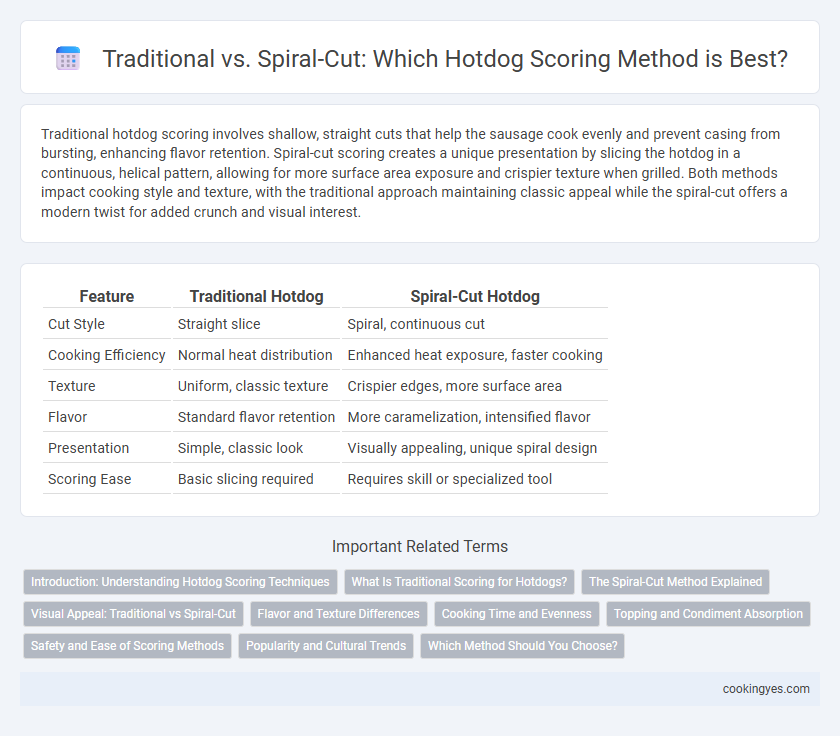Traditional hotdog scoring involves shallow, straight cuts that help the sausage cook evenly and prevent casing from bursting, enhancing flavor retention. Spiral-cut scoring creates a unique presentation by slicing the hotdog in a continuous, helical pattern, allowing for more surface area exposure and crispier texture when grilled. Both methods impact cooking style and texture, with the traditional approach maintaining classic appeal while the spiral-cut offers a modern twist for added crunch and visual interest.
Table of Comparison
| Feature | Traditional Hotdog | Spiral-Cut Hotdog |
|---|---|---|
| Cut Style | Straight slice | Spiral, continuous cut |
| Cooking Efficiency | Normal heat distribution | Enhanced heat exposure, faster cooking |
| Texture | Uniform, classic texture | Crispier edges, more surface area |
| Flavor | Standard flavor retention | More caramelization, intensified flavor |
| Presentation | Simple, classic look | Visually appealing, unique spiral design |
| Scoring Ease | Basic slicing required | Requires skill or specialized tool |
Introduction: Understanding Hotdog Scoring Techniques
Hotdog scoring techniques such as traditional and spiral-cut methods significantly enhance flavor absorption and texture. Traditional scoring involves simple, shallow cuts that prevent splitting during cooking, while spiral-cut scoring creates a distinctive helical pattern that increases the surface area for spices and sauces. Both techniques cater to different culinary preferences and presentation styles, optimizing the hotdog eating experience.
What Is Traditional Scoring for Hotdogs?
Traditional scoring for hotdogs involves making a few shallow, straight cuts along the length of the sausage, allowing even cooking and preventing the casing from splitting during grilling. This method enhances the flavor by providing slight caramelization on the exposed surfaces while maintaining the hotdog's juiciness. Traditional cuts also create a classic appearance favored in many regional recipes, contributing to the nostalgic hotdog experience.
The Spiral-Cut Method Explained
The spiral-cut method for hotdog scoring involves slicing the sausage in a continuous spiral pattern, which increases the surface area and allows for more even cooking and enhanced flavor absorption from seasonings or sauces. This technique also creates a visually appealing presentation and a crispy texture along the cut edges, distinguishing it from the traditional straight cuts. Spiral-cut hotdogs retain juiciness while offering a unique eating experience due to the balanced combination of tenderness and crispness.
Visual Appeal: Traditional vs Spiral-Cut
Traditional hotdog scoring features simple straight slits that create a classic grilled appearance, enhancing the sausage's texture and allowing juices to escape evenly. Spiral-cut scoring produces a distinctive corkscrew pattern that increases surface area, resulting in a more visually striking and evenly crisped exterior. The spiral-cut method elevates visual appeal by creating dynamic grill marks and a unique presentation compared to the straightforward, familiar look of traditional scoring.
Flavor and Texture Differences
Traditional hotdog scoring creates shallow cuts that enhance flavor by allowing seasonings to penetrate the meat evenly, while maintaining a classic, firm texture. Spiral-cut scoring increases surface area, resulting in a crispier outer layer and a more complex texture contrast between crunchy edges and juicy interior. Both methods offer unique flavor profiles, with spiral cuts often providing a more intense smoky and charred taste due to increased browning during grilling.
Cooking Time and Evenness
Traditional hotdog scoring involves simple slits that cook quickly but may result in uneven heat distribution, potentially causing some parts to overcook while others remain undercooked. Spiral-cut scoring increases the surface area, allowing heat to penetrate more uniformly, which reduces overall cooking time and ensures even doneness throughout the hotdog. This method enhances grilling or pan-frying efficiency, delivering consistent texture and flavor in less time.
Topping and Condiment Absorption
Traditional hotdog scoring creates shallow cuts that help hold toppings like mustard, ketchup, and relish on the surface, providing a balanced flavor with each bite. Spiral-cut scoring increases surface area, allowing condiments to seep deeper into the meat, enhancing overall taste and ensuring every bite is infused with seasoning. This method also improves absorption of wetter toppings such as sauerkraut and onions, making the hotdog more flavorful and juicy.
Safety and Ease of Scoring Methods
Traditional hotdog scoring involves simple straight cuts that reduce the risk of deep slicing, enhancing user safety by minimizing sharp edges and potential injury. Spiral-cut scoring creates a uniform, decorative spiral pattern that can be more challenging to execute safely without practice, potentially increasing the likelihood of slips while scoring. For ease and safety, traditional scoring is preferred by beginners, while spiral cuts require steady control and specialized knives to achieve precise, consistent results.
Popularity and Cultural Trends
Traditional hotdog scoring remains popular for its simplicity and classic appeal, particularly in American cookouts and street food culture. Spiral-cut hotdogs have grown in popularity due to their unique presentation and even cooking, favored in trendy food festivals and modern culinary scenes. Cultural trends indicate that spiral cuts appeal more to younger, adventurous eaters while traditional scoring holds strong nostalgic value among older generations.
Which Method Should You Choose?
Traditional hotdog scoring creates simple, straight cuts that help the sausage cook evenly and retain juiciness, making it ideal for classic grilling and providing a familiar texture. Spiral-cut scoring offers a visually appealing, corkscrew effect that increases surface area for a crispier bite and better absorption of seasonings and sauces, enhancing flavor complexity. Choose traditional scoring for straightforward grilling and texture, or opt for spiral-cut scoring to maximize crispiness and absorb more toppings for a gourmet experience.
Traditional vs Spiral-cut for hotdog scoring Infographic

 cookingyes.com
cookingyes.com